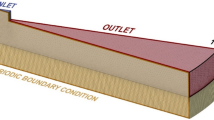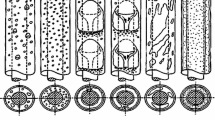Abstract
The HOLLOW JET NOZZLE (HJN) is a heat exchanger used for the removal of superheat from molten steel between tundish and mold. It is a relatively new technology, developed by CRM, Belgium, through engineering the design of the conventional submerged entry nozzle (SEN) in continuous casting. In the present study, fluid-flow phenomena in a HJN system were investigated experimentally via a 0.23-scale water model, designed and operated on the basis of a Froude scaling criterion. Parallel to such, numerical simulation was carried out via FLUENT 6.1 embodying a turbulent, VOF-based, multiphase flow calculation procedure. These, in general, indicated that the incoming liquid, following its impingement on the solid baffle, spreads radially and flows down as a thin liquid film along the wall of the HJN. A large number of experiments were carried out to determine the radial spread of the impinging water jet and its point of attachment on the wall of the HJN as a function of volumetric flow rate, baffle geometry and dimensions, diameter of HJN, etc. These indicated that baffle geometry and dimensions together with the diameter of the HJN influence the point of attachment (or the corresponding “attachment distance”) most. It was demonstrated that attachment distance and the associated contact area between the flowing liquid and HJN wall can be considerably improved by appropriately modifying the currently employed baffle design. Such experimental findings were corroborated well by the FLUENT-based numerical procedure, which was in general able to capture the intricacies of film flow in the HJN system reasonably accurately. In addition to these, simplified models for attachment distance and film thickness have been developed and proposed for axisymmetrical HJN operation. Based on such, a relatively simple differential heat flow model has been developed for prediction of melt temperature in an industrial HJN system. It is demonstrated that in the absence of any elaborate numerical computation, the simplified models developed in this study provide a reasonable basis for engineering calculations in the axisymmetrical HJN system.
















Similar content being viewed by others
Notes
HOLLOW JET NOZZLE is a trademark of CRM, Brussels, Belgium.
Heat from the flowing melt is removed by circulating water along the periphery of the central cylindrical portion (i.e., termed as the throat) of the HJN.
PERSPEX is a trademark of Lucite International UK Ltd.
FLUENT 6.1 is a trademark of Fluent Inc. Lebanon, NH, USA.
GAMBIT is a trademark of Fluent Inc. Lebanon, NH, USA.
Abbreviations
- A HJN :
-
liquid-wall contact area in the HJN (=2πR HJN(L Throat−Z Att)
- A n :
-
area of flow inlet in HJN (=exit nozzle area of the tundish)
- C P :
-
specific heat of steel
- D :
-
diameter of the solid baffle
- d cl :
-
distance of separation between the apex of the baffle and the inlet
- d n :
-
diameter of the tundish outlet (or HJN inlet) nozzle
- D HJN :
-
diameter of the HJN at the throat
- g :
-
acceleration due to gravity
- h :
-
height of the tapered portion of the baffle
- L Throat :
-
throat length
- L tot :
-
total length of the HJN
- \( {\mathop m\limits^{\text{o}} } \) :
-
mass flow rate of steel
- q HJN :
-
heat flux through the wall of the HJN
- \( {\mathop Q\limits^{\text{o}} } \) :
-
volumetric flow rate
- r :
-
radial coordinate
- R HJN :
-
radius of the HJN
- T :
-
temperature
- T ex,tundish :
-
exit melt temperature from the tundish
- T des,mold :
-
desired temperature of steel in the mold
- u z :
-
axial component of flow in the film
- u r :
-
vertical component of flow in the film
- V z :
-
idealized vertical flow component at the point of attachment, deduced on the basis of volume continuity
- V :
-
average incoming velocity of liquid into the HJN (=\( {\mathop Q\limits^{\text{o}} }/A_{n} \))
- W :
-
width of the flat plat
- x :
-
the radial width of the film
- y + :
-
dimensionless perpendicular distance from the near wall node to the wall
- z :
-
axial coordinate or axial distance below the apex of the baffle
- Z 0 :
-
the vertical distance below the apex of the baffle at which the film connects with the wall of the HJN
- Z Att :
-
attachment distance (=Z 0 + d cl )
- δ :
-
film thickness
- ν:
-
kinematic viscosity
- α eff :
-
effective thermal diffusivity (=eddy kinematic viscosity/σ t )
- σ t :
-
turbulent Prandtl number (=1.0)
References
J.P. Birat, M. Bobadilla, J.L. Jacquot, M. Martinot, J. Rour, L. Backer, J.M Bastin: Proc. Continuous Casting, Institute of Metals, London, 1985, pp. 18.1–18.8
P. Naveau, S. Wilmotte, C. Albrecq: Proc. Steelmaking Conf., ISS, Warrendale, PA, 1996, pp. 228–34
D. Mazumdar, G. Yamanoglu, S. Ramani, R.I.L. Guthrie: Steel Res., 1995, vol. 66, pp. 14–19
Fluent Users Manual 6.1, Fluent Inc., Lebanon, NH
M. Rudman: Int. J. Num., Meth. Fluids, 1997, vol. 24, pp. 671–83
B.E. Launder, D.B. Spalding: Comput. Meth. Appl. Mech. Eng., 1974, vol. 3, pp. 269–84.
G. Leneweit, K.G. Roesner, R. Koehler: Exp. Fluids, 1999, vol. 26, pp. 75–85
P.S. Lawrence, B.N. Rao: Acta Mech., 1999, vol. 89, pp. 21–31
K.J. Ruschak and S.J. Weinstein: J. Fluids Eng., vol. 122, pp. 774–78
R Guthrie: Engineering in Process Metallurgy, Clarendon Press, Oxford, United Kingdom, 1989
R.B. Bird, W. Stewart, E.N. Lightfoot: Transport Phenomena, 2nd ed., John Wiley and Sons, New York, NY, 2002
S. Joo, J.W. Han, R.I.L. Guthrie: Metall. Trans. , 1993, vol. 24B, pp. 767–77
S. Chakraborty, Y. Sahai: Ironmaking and Steelmaking, 1992, vol. 19 (6), pp 488–94
S.P. Patil, D. Mazumdar: Steel Grips, 2007, vol. 1, pp. 43–50
T. Ishi, N. Kubo, T.K. Bose, M. Iguchi: ISIJ Int., 2001, vol. 41 (10), pp. 1174–80
D. Mazumdar: Internal Report No. ISPAT/Dolvi/I/2004, IIT, Kanpur, India
D. Mazumdar: Internal Report No. Mukand/Hospet/I/2006, IIT, Kanpur, India
Acknowledgments
The authors gratefully acknowledge the financial support for the present work in the form of a sponsored research grant from the Department of Science and Technology (New Delhi, Government of India).
Author information
Authors and Affiliations
Corresponding author
Additional information
Manuscript submitted September 7, 2006.
Rights and permissions
About this article
Cite this article
Chatterjee, D., Mazumdar, D. & Patil, S. Physical and Mathematical Modeling of Two-Phase Flows in a HOLLOW JET NOZZLE. Metall Mater Trans B 38, 819–831 (2007). https://doi.org/10.1007/s11663-007-9084-8
Published:
Issue Date:
DOI: https://doi.org/10.1007/s11663-007-9084-8




